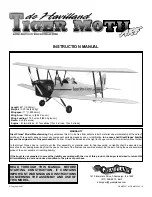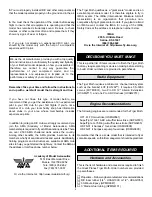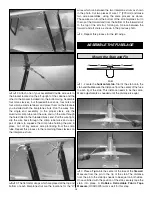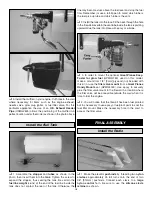
5. You must properly install all R/C and other components so
that the model operates properly on the ground and in the air.
6. You must check the operation of the model before every
flight to insure that all equipment is operating and that the
model has remained structurally sound. Be sure to check
clevises or other connectors often and replace them if they
show any signs of wear or fatigue.
7. If you are not already an experienced R/C pilot, you
should fly the model only with the help of a competent,
experienced R/C pilot.
Remember: Take your time and follow the instructions to
end up with a well-built model that is straight and true.
If you have not flown this type of model before, we
recommend that you get the assistance of an experienced
pilot in your R/C club for your first flights. If you're not a
member of a club, your local hobby shop has information
about clubs in your area whose membership includes
experienced pilots.
In addition to joining an R/C club, we strongly recommend you
join the AMA (Academy of Model Aeronautics). AMA
membership is required to fly at AMA sanctioned clubs. There
are over 2,500 AMA chartered clubs across the country.
Among other benefits, the AMA provides insurance to its
members who fly at sanctioned sites and events. Additionally,
training programs and instructors are available at AMA club
sites to help you get started the right way. Contact the AMA at
the address or toll-free phone number below:
Academy of Model Aeronautics
5151 East Memorial Drive
Muncie, IN 47302-9252
Tele. (800) 435-9262
Fax (765) 741-0057
Or via the Internet at:
http://www.modelaircraft.org
The Tiger Moth qualifies as a "giant scale" model and is an
excellent sport-scale model. It is therefore eligible to fly in
IMAA events. The IMAA (International Miniature Aircraft
Association) is an organization that promotes non-
competitive flying of giant-scale models. If you plan to attend
an IMAA event, contact the IMAA for a copy of the IMAA
Safety Code at the address or telephone number below.
IMAA
205 S. Hilldale Road
Salina, KS 67401
(866) 366-4622
Or via the Internet at: http://www.fly-imaa.org
This is a partial list of items required to finish the Tiger Moth
that may require planning or decision making before starting
to build. Order numbers are provided in parentheses.
The Tiger Moth requires a minimum 4 channel radio system
such as the Futaba
®
4VF (FUTJ62**). It requires 5 S-3003
servos (FUTM0031), two Pro HD 12" Aileron Extensions
(HCAM2711), and one Pro HD Y-Harness (HCAM2751).
The following engines are recommended for the Tiger Moth:
OS
®
.61 FX two-stroke (OSMG0561)
SuperTigre
®
G-61 ABC w/muffler two-stroke (SUPG0181)
SuperTigre G-75 Ring w/muffler two-stroke (SUPG0205)
OS FS-91 II Surpass
™
four-stroke (OSMG0896)
OS FS-91 II Surpass w/pump four-stroke (OSMG0890)
Remember that this is a scale model that is intended to fly at
scale-like speeds, so throttle management should be practiced.
This is the list of hardware and accessories required to finish
the Great Planes Tiger Moth. Order numbers are provided
in parentheses.
❏
Propellers – Follow engine manufacturer’s recommendations
❏
R/C foam rubber (1/4" - HCAQ1000, or 1/2" - HCAQ1050)
❏
30-Minute Epoxy (GPMR6047)
❏
3' Medium fuel tubing (GPMQ4131)
Hardware and Accessories
ADDITIONAL ITEMS REQUIRED
Engine Recommendations
Radio Equipment
DECISIONS YOU MUST MAKE
We, as the kit manufacturer, provide you with a top quality
kit and instructions, but ultimately the quality and flyability
of your finished model depends on how you assemble it;
therefore, we cannot in any way guarantee the
performance of your completed model, and no
representations are expressed or implied as to the
performance or safety of your completed model.
3




































